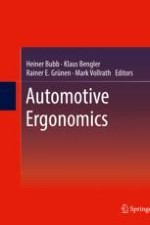2021 | OriginalPaper | Buchkapitel
11. Measurement Techniques
verfasst von : Klaus Bengler, Heiner Bubb, Christian Lange, Carmen Aringer-Walch, Nicole Trübswetter, Antonia Conti-Kufner, Markus Zimmermann
Erschienen in: Automotive Ergonomics
Verlag: Springer Fachmedien Wiesbaden
Aktivieren Sie unsere intelligente Suche, um passende Fachinhalte oder Patente zu finden.
Wählen Sie Textabschnitte aus um mit Künstlicher Intelligenz passenden Patente zu finden. powered by
Markieren Sie Textabschnitte, um KI-gestützt weitere passende Inhalte zu finden. powered by
